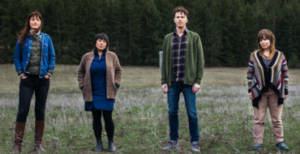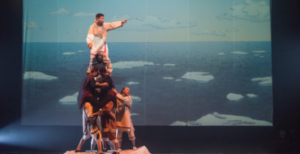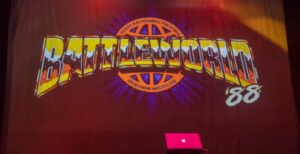
The Penny Arcade Expo, more commonly known as PAX, is a convention held in Seattle every year for a whole weekend. Surrounded by video and tabletop games; game developers and players all come together to share in their love of the industry, exchange news and knowledge, and most importantly – to play games together.
Penny Arcade is a webcomic about video games, founded by writer Jerry Holkins and artist Mike Krahulik in 1998 as a place to critique the gaming industry and culture. Holkins & Krahulik would frequently get caught in legal bad weather as a result, with their tendency to piss everyone off. Now, they are still a webcomic, but they also run a
charity that since 2003 has sent over $12m to Children’s Hospitals, a
scholarship for students impacting the games industry, a
subsidiary site that runs some of the best long-form games journalism on the web, and several
other projects. Oh, and they also run one of the largest consumer-oriented gaming conventions in the world,
PAX.
But that’s enough about Penny Arcade, because curiously enough, the expo doesn’t actually have that much to do with them. It was created for people who love video games – surely Penny Arcade put it together, but it’s not theirs – PAX is truly owned by the 70,000 plus gamers and developers that descend upon the Washington Convention Center every year. This year, for the ninth PAX Prime (PAX East in Boston began two years ago), I traveled down to Seattle for the first time to see what it was all about.
There is a friendliness and passion that emanates from the people at PAX. You can have an in-depth conversation about the turmoil of Goblin Adolescence with someone dressed as a banana, and suddenly start feeling very comfortable about your own perceived weirdness.
While the expo floor is an assault of lights and sound that gets into your head and invasively begins unplugging things and rewiring your sense of time and energy so much so that you forget to eat and your mouth hangs agape in rapture as you travel from booth to booth. There is another facet of PAX that is surprisingly… academic. Throughout the event, there were many, many panels that took place in the theatres and hotel conference rooms surrounding the convention centre, many of them to do with professional development. I spent more time in panels than out on the floor, because the opportunity to hear real industry people speak on a range of topics, from sexuality, character design, game reviewing, journalism, and art was an amazing opportunity – especially considering they all consisted of audience Q&A sessions. It’s also a quiet respite from the cacophony of the expo floor. Other panels were more typical expo fare – retrospectives, interviews, and product reveals. But the knowledge and perspective gained from industry vets talking about what they do and how they do it was absolutely fascinating. If ever you go, plan to see as many of these as you can.
Of course, what everyone wants to know when talking about a game convention is, well, the games. Rest assured, there was a
lot. The expected customers were all there – Square Enix had Tomb Raider, Sony had The Last of Us and God of War Ascension, and Microsoft had Halo 4. Assassin’s Creed III was over at Ubisoft, and Konami built a castle that housed Metal Gear Rising Revengeance. But I didn’t go play any of these – their booths were filled with PR reps, spiraling lineups, and there wasn’t anything there that I can’t see later. Waiting in line for two hours to play twenty minutes of Resident Evil 6 is not exactly appealing to me. But even if you didn’t play the games, just seeing the massive booths (some of them were practically buildings in their own right), the costumed booth staff, and the huge sets and statues was entertaining enough
What really caught my attention, was a section of the show floor dedicated to Indie Games. The Indie Megabooth is an array of interconnected booths that are brimming with creative games, experiments, and technology. The great thing is that there was nobody at these booths except the passionate developers themselves, who are eager to watch you play, tell you all about it, and answer all your questions. There’s rarely a line either, so making your way through the booths and stopping at each game is incredibly easy and fulfilling. Some of the most creative projects can be found there, and the reason it’s so imperative to give these games time, is that there’s no guarantee you will be able to see them again for a long time, tumultuous as indie game development can sometimes be.
The projects on display were incredibly creative. One stand-out was a game by Danish developer Douglas Wilson titled
Johann Sebastian Joust. It’s only a video game in the thinnest sense of the word – you hold a controller, but there is no video. In JSJ, you hold a PlayStation Move controller in your hand and must keep it steady to the rhythm of classical music – while avoiding the physical attacks of the other players around you. If your controller moves too fast, the light on the end goes out, and so do you. Playing it feels like you’re trying to balance plates, only there’s a bunch of jerks around you trying to hit them down. It’s a game that really needs to be seen to be understood, but it demonstrates the way a lot of designers are changing the gaming world.
Another game I sat down with extensively was
Spy Party, created by US game designer Chris Hecker. With plans to make it a competitive multiplayer sport like Counter-Strike or DOTA, it is decidedly different than the usual twitch-fast, intensely insular experiences expected of competitive multiplayer games. Spy Party is a 1 vs. 1 game of methodical observation. It sounds riveting – I know, which is why Chris is right when he says it needs to be played to be understood. In Spy Party, one person acts as spy, a guest at a formal party, who must try his best to act like an NPC while completing various objectives like bugging an ambassador, or stealing a briefcase. The sniper has one shot, and must carefully observe the party from outside, trying to spot the human player before time runs out and make the shot. The game is intense for both players – one wrong move can be catastrophic, but it is a lot of fun. While I’m not sure how it will fit into the competitive space, it is certainly very unique and very fun.
There were others that deserve mention – Primer Labs’ dungeon-crawling Javascript-editing
Code Hero, Alexander Bruce’s Escher-like art-puzzler
Antichamber, and the hilarious
Guacamelee! from Drinkbox Studios. Vancouver’s own Klei Entertainment was there showing off Mark of the Ninja (which will have a review forthcoming on our site), as well as a new survival game called
Don’t Starve, which you can play the beta version of for free in your Chrome web browser right now!
The Indie Megabooth has continually expanded over the years and is now one of the hottest attractions at the convention. With a growing indie community and things like the PAX 10, which is a selection of 10 new and unique indie games that get prominent mention, the space is growing in the eyes of gamers. Many of the people I talked to at PAX said that their favorite games were found within the Indie Megabooth because they are just so much unlike anything else on the floor.
With PAX behind me, I’m looking forward to the next year in gaming, both in terms of AAA and indie releases. There is definitely a stronger and more exciting presence from the indie side of things than ever before, and there’s so many people making games all the time, there’s never a bad time to look for something to play.
The best part is, you don’t need to go to PAX to play new “unreleased” games these days, because “unreleased” doesn’t really mean anything anymore. Many smaller games are available already online, and even bigger games are starting to follow suit, with the prevalence of public betas for games like Natural Selection II.
So I encourage you to get online and support some Indie Game Developers. And the next time PAX rolls around, you can go and talk to them in person. You can tell them what you liked and what you didn’t like, you can be part of a community that just create great games… and then of course you can play those great games.
 The Penny Arcade Expo, more commonly known as PAX, is a convention held in Seattle every year for a whole weekend. Surrounded by video and tabletop games; game developers and players all come together to share in their love of the industry, exchange news and knowledge, and most importantly – to play games together.
Penny Arcade is a webcomic about video games, founded by writer Jerry Holkins and artist Mike Krahulik in 1998 as a place to critique the gaming industry and culture. Holkins & Krahulik would frequently get caught in legal bad weather as a result, with their tendency to piss everyone off. Now, they are still a webcomic, but they also run a charity that since 2003 has sent over $12m to Children’s Hospitals, a scholarship for students impacting the games industry, a subsidiary site that runs some of the best long-form games journalism on the web, and several other projects. Oh, and they also run one of the largest consumer-oriented gaming conventions in the world, PAX.
But that’s enough about Penny Arcade, because curiously enough, the expo doesn’t actually have that much to do with them. It was created for people who love video games – surely Penny Arcade put it together, but it’s not theirs – PAX is truly owned by the 70,000 plus gamers and developers that descend upon the Washington Convention Center every year. This year, for the ninth PAX Prime (PAX East in Boston began two years ago), I traveled down to Seattle for the first time to see what it was all about.
There is a friendliness and passion that emanates from the people at PAX. You can have an in-depth conversation about the turmoil of Goblin Adolescence with someone dressed as a banana, and suddenly start feeling very comfortable about your own perceived weirdness.
While the expo floor is an assault of lights and sound that gets into your head and invasively begins unplugging things and rewiring your sense of time and energy so much so that you forget to eat and your mouth hangs agape in rapture as you travel from booth to booth. There is another facet of PAX that is surprisingly… academic. Throughout the event, there were many, many panels that took place in the theatres and hotel conference rooms surrounding the convention centre, many of them to do with professional development. I spent more time in panels than out on the floor, because the opportunity to hear real industry people speak on a range of topics, from sexuality, character design, game reviewing, journalism, and art was an amazing opportunity – especially considering they all consisted of audience Q&A sessions. It’s also a quiet respite from the cacophony of the expo floor. Other panels were more typical expo fare – retrospectives, interviews, and product reveals. But the knowledge and perspective gained from industry vets talking about what they do and how they do it was absolutely fascinating. If ever you go, plan to see as many of these as you can.
Of course, what everyone wants to know when talking about a game convention is, well, the games. Rest assured, there was a lot. The expected customers were all there – Square Enix had Tomb Raider, Sony had The Last of Us and God of War Ascension, and Microsoft had Halo 4. Assassin’s Creed III was over at Ubisoft, and Konami built a castle that housed Metal Gear Rising Revengeance. But I didn’t go play any of these – their booths were filled with PR reps, spiraling lineups, and there wasn’t anything there that I can’t see later. Waiting in line for two hours to play twenty minutes of Resident Evil 6 is not exactly appealing to me. But even if you didn’t play the games, just seeing the massive booths (some of them were practically buildings in their own right), the costumed booth staff, and the huge sets and statues was entertaining enough
What really caught my attention, was a section of the show floor dedicated to Indie Games. The Indie Megabooth is an array of interconnected booths that are brimming with creative games, experiments, and technology. The great thing is that there was nobody at these booths except the passionate developers themselves, who are eager to watch you play, tell you all about it, and answer all your questions. There’s rarely a line either, so making your way through the booths and stopping at each game is incredibly easy and fulfilling. Some of the most creative projects can be found there, and the reason it’s so imperative to give these games time, is that there’s no guarantee you will be able to see them again for a long time, tumultuous as indie game development can sometimes be.
The projects on display were incredibly creative. One stand-out was a game by Danish developer Douglas Wilson titled Johann Sebastian Joust. It’s only a video game in the thinnest sense of the word – you hold a controller, but there is no video. In JSJ, you hold a PlayStation Move controller in your hand and must keep it steady to the rhythm of classical music – while avoiding the physical attacks of the other players around you. If your controller moves too fast, the light on the end goes out, and so do you. Playing it feels like you’re trying to balance plates, only there’s a bunch of jerks around you trying to hit them down. It’s a game that really needs to be seen to be understood, but it demonstrates the way a lot of designers are changing the gaming world.
Another game I sat down with extensively was Spy Party, created by US game designer Chris Hecker. With plans to make it a competitive multiplayer sport like Counter-Strike or DOTA, it is decidedly different than the usual twitch-fast, intensely insular experiences expected of competitive multiplayer games. Spy Party is a 1 vs. 1 game of methodical observation. It sounds riveting – I know, which is why Chris is right when he says it needs to be played to be understood. In Spy Party, one person acts as spy, a guest at a formal party, who must try his best to act like an NPC while completing various objectives like bugging an ambassador, or stealing a briefcase. The sniper has one shot, and must carefully observe the party from outside, trying to spot the human player before time runs out and make the shot. The game is intense for both players – one wrong move can be catastrophic, but it is a lot of fun. While I’m not sure how it will fit into the competitive space, it is certainly very unique and very fun.
There were others that deserve mention – Primer Labs’ dungeon-crawling Javascript-editing Code Hero, Alexander Bruce’s Escher-like art-puzzler Antichamber, and the hilarious Guacamelee! from Drinkbox Studios. Vancouver’s own Klei Entertainment was there showing off Mark of the Ninja (which will have a review forthcoming on our site), as well as a new survival game called Don’t Starve, which you can play the beta version of for free in your Chrome web browser right now!
The Indie Megabooth has continually expanded over the years and is now one of the hottest attractions at the convention. With a growing indie community and things like the PAX 10, which is a selection of 10 new and unique indie games that get prominent mention, the space is growing in the eyes of gamers. Many of the people I talked to at PAX said that their favorite games were found within the Indie Megabooth because they are just so much unlike anything else on the floor.
With PAX behind me, I’m looking forward to the next year in gaming, both in terms of AAA and indie releases. There is definitely a stronger and more exciting presence from the indie side of things than ever before, and there’s so many people making games all the time, there’s never a bad time to look for something to play.
The best part is, you don’t need to go to PAX to play new “unreleased” games these days, because “unreleased” doesn’t really mean anything anymore. Many smaller games are available already online, and even bigger games are starting to follow suit, with the prevalence of public betas for games like Natural Selection II.
So I encourage you to get online and support some Indie Game Developers. And the next time PAX rolls around, you can go and talk to them in person. You can tell them what you liked and what you didn’t like, you can be part of a community that just create great games… and then of course you can play those great games.
The Penny Arcade Expo, more commonly known as PAX, is a convention held in Seattle every year for a whole weekend. Surrounded by video and tabletop games; game developers and players all come together to share in their love of the industry, exchange news and knowledge, and most importantly – to play games together.
Penny Arcade is a webcomic about video games, founded by writer Jerry Holkins and artist Mike Krahulik in 1998 as a place to critique the gaming industry and culture. Holkins & Krahulik would frequently get caught in legal bad weather as a result, with their tendency to piss everyone off. Now, they are still a webcomic, but they also run a charity that since 2003 has sent over $12m to Children’s Hospitals, a scholarship for students impacting the games industry, a subsidiary site that runs some of the best long-form games journalism on the web, and several other projects. Oh, and they also run one of the largest consumer-oriented gaming conventions in the world, PAX.
But that’s enough about Penny Arcade, because curiously enough, the expo doesn’t actually have that much to do with them. It was created for people who love video games – surely Penny Arcade put it together, but it’s not theirs – PAX is truly owned by the 70,000 plus gamers and developers that descend upon the Washington Convention Center every year. This year, for the ninth PAX Prime (PAX East in Boston began two years ago), I traveled down to Seattle for the first time to see what it was all about.
There is a friendliness and passion that emanates from the people at PAX. You can have an in-depth conversation about the turmoil of Goblin Adolescence with someone dressed as a banana, and suddenly start feeling very comfortable about your own perceived weirdness.
While the expo floor is an assault of lights and sound that gets into your head and invasively begins unplugging things and rewiring your sense of time and energy so much so that you forget to eat and your mouth hangs agape in rapture as you travel from booth to booth. There is another facet of PAX that is surprisingly… academic. Throughout the event, there were many, many panels that took place in the theatres and hotel conference rooms surrounding the convention centre, many of them to do with professional development. I spent more time in panels than out on the floor, because the opportunity to hear real industry people speak on a range of topics, from sexuality, character design, game reviewing, journalism, and art was an amazing opportunity – especially considering they all consisted of audience Q&A sessions. It’s also a quiet respite from the cacophony of the expo floor. Other panels were more typical expo fare – retrospectives, interviews, and product reveals. But the knowledge and perspective gained from industry vets talking about what they do and how they do it was absolutely fascinating. If ever you go, plan to see as many of these as you can.
Of course, what everyone wants to know when talking about a game convention is, well, the games. Rest assured, there was a lot. The expected customers were all there – Square Enix had Tomb Raider, Sony had The Last of Us and God of War Ascension, and Microsoft had Halo 4. Assassin’s Creed III was over at Ubisoft, and Konami built a castle that housed Metal Gear Rising Revengeance. But I didn’t go play any of these – their booths were filled with PR reps, spiraling lineups, and there wasn’t anything there that I can’t see later. Waiting in line for two hours to play twenty minutes of Resident Evil 6 is not exactly appealing to me. But even if you didn’t play the games, just seeing the massive booths (some of them were practically buildings in their own right), the costumed booth staff, and the huge sets and statues was entertaining enough
What really caught my attention, was a section of the show floor dedicated to Indie Games. The Indie Megabooth is an array of interconnected booths that are brimming with creative games, experiments, and technology. The great thing is that there was nobody at these booths except the passionate developers themselves, who are eager to watch you play, tell you all about it, and answer all your questions. There’s rarely a line either, so making your way through the booths and stopping at each game is incredibly easy and fulfilling. Some of the most creative projects can be found there, and the reason it’s so imperative to give these games time, is that there’s no guarantee you will be able to see them again for a long time, tumultuous as indie game development can sometimes be.
The projects on display were incredibly creative. One stand-out was a game by Danish developer Douglas Wilson titled Johann Sebastian Joust. It’s only a video game in the thinnest sense of the word – you hold a controller, but there is no video. In JSJ, you hold a PlayStation Move controller in your hand and must keep it steady to the rhythm of classical music – while avoiding the physical attacks of the other players around you. If your controller moves too fast, the light on the end goes out, and so do you. Playing it feels like you’re trying to balance plates, only there’s a bunch of jerks around you trying to hit them down. It’s a game that really needs to be seen to be understood, but it demonstrates the way a lot of designers are changing the gaming world.
Another game I sat down with extensively was Spy Party, created by US game designer Chris Hecker. With plans to make it a competitive multiplayer sport like Counter-Strike or DOTA, it is decidedly different than the usual twitch-fast, intensely insular experiences expected of competitive multiplayer games. Spy Party is a 1 vs. 1 game of methodical observation. It sounds riveting – I know, which is why Chris is right when he says it needs to be played to be understood. In Spy Party, one person acts as spy, a guest at a formal party, who must try his best to act like an NPC while completing various objectives like bugging an ambassador, or stealing a briefcase. The sniper has one shot, and must carefully observe the party from outside, trying to spot the human player before time runs out and make the shot. The game is intense for both players – one wrong move can be catastrophic, but it is a lot of fun. While I’m not sure how it will fit into the competitive space, it is certainly very unique and very fun.
There were others that deserve mention – Primer Labs’ dungeon-crawling Javascript-editing Code Hero, Alexander Bruce’s Escher-like art-puzzler Antichamber, and the hilarious Guacamelee! from Drinkbox Studios. Vancouver’s own Klei Entertainment was there showing off Mark of the Ninja (which will have a review forthcoming on our site), as well as a new survival game called Don’t Starve, which you can play the beta version of for free in your Chrome web browser right now!
The Indie Megabooth has continually expanded over the years and is now one of the hottest attractions at the convention. With a growing indie community and things like the PAX 10, which is a selection of 10 new and unique indie games that get prominent mention, the space is growing in the eyes of gamers. Many of the people I talked to at PAX said that their favorite games were found within the Indie Megabooth because they are just so much unlike anything else on the floor.
With PAX behind me, I’m looking forward to the next year in gaming, both in terms of AAA and indie releases. There is definitely a stronger and more exciting presence from the indie side of things than ever before, and there’s so many people making games all the time, there’s never a bad time to look for something to play.
The best part is, you don’t need to go to PAX to play new “unreleased” games these days, because “unreleased” doesn’t really mean anything anymore. Many smaller games are available already online, and even bigger games are starting to follow suit, with the prevalence of public betas for games like Natural Selection II.
So I encourage you to get online and support some Indie Game Developers. And the next time PAX rolls around, you can go and talk to them in person. You can tell them what you liked and what you didn’t like, you can be part of a community that just create great games… and then of course you can play those great games. 








